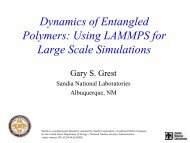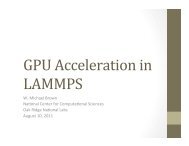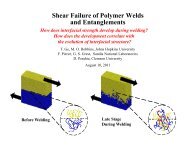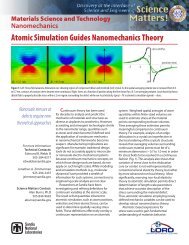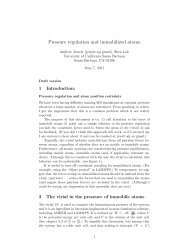Multiscale modeling of PECVD generated Silicon films ... - Lammps
Multiscale modeling of PECVD generated Silicon films ... - Lammps
Multiscale modeling of PECVD generated Silicon films ... - Lammps
You also want an ePaper? Increase the reach of your titles
YUMPU automatically turns print PDFs into web optimized ePapers that Google loves.
Figure 12 - Example Attack Tree for VPN partner connectionThe attack tree in Figure 12 is a horizontal tree that adheres to the guidelines discussed in the previoustree’s description. In this tree, the grey nodes are the conditional nodes <strong>of</strong> the tree, the red nodes areresultant conditions, green nodes are security controls and the orange nodes are threat actors/attackagents. This tree is shown as a comparison to the tree in Figure 11 – to illustrate the flexibility andcreativity possible with attack trees.Threat Pr<strong>of</strong>ilesFor the purposes <strong>of</strong> this paper, a threat pr<strong>of</strong>ile is defined as a tabular summary <strong>of</strong> threats, attacks andrelated characteristics. The tabular format allows for a large degree <strong>of</strong> flexibility in terms <strong>of</strong> the columnsand rows selected for each pr<strong>of</strong>ile. Threat pr<strong>of</strong>iles are an excellent tool for communicating the results <strong>of</strong>completed threat models and/or attack trees. They also allow for consolidation, sorting, pivoting and othercommon data manipulation functions. Providing detailed descriptions <strong>of</strong> both the cause and effect <strong>of</strong>threats and attack vectors is an ideal use case for threat pr<strong>of</strong>iles.For comparison, some assessment practices use the term threat pr<strong>of</strong>ile to describe a decomposition that ismuch more analogous to an attack tree [5], while others are more congruent with the description providedin this paper [13]. More recently, the term threat pr<strong>of</strong>ile has been used in the development <strong>of</strong> cyber threatintelligence.Table 2 presents a generic threat pr<strong>of</strong>ile template. Table 3, along with Listing 1, and Table 4 illustratecase study threat pr<strong>of</strong>iles. The differences in scope and applicability between Tables 3 and 4 are describedas follows: Table 3 is a more granular pr<strong>of</strong>ile and Table 4 is an example <strong>of</strong> a large-scale, detailed analysispresented as a summarized and aggregate data set. These two examples demonstrate the flexibility andscalability <strong>of</strong> threat pr<strong>of</strong>iles.© Lockheed Martin Corporation19


